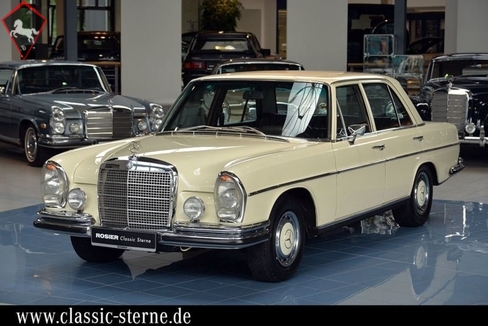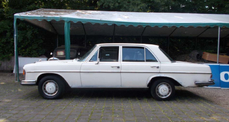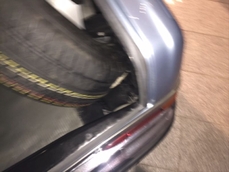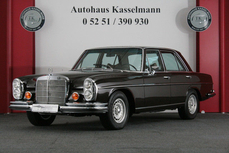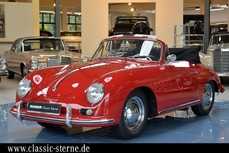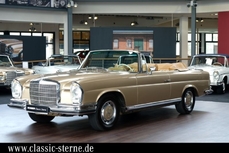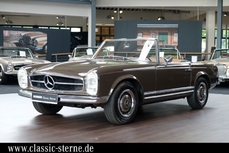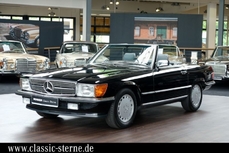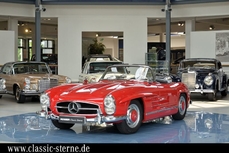Mercedes-Benz 280S/SE/SEL 3.5 w108 SE 3.5 Limousine W108 1971
General description :
Interne Fahrzeugnr.: 20460
1971 ausgeliefert in die Schweiz, war die elegante Limousine mit dem kraftvollen 3.5 Liter V8 Motor bis 2010 im malerischen Tessin/Schweiz zu Hause.Sie war all die Jahre im Besitz von Alberto Vicari in Ponte Tresa, einer Gemeinde am Luganer See. In 2010 kam die Limousine in den Besitz von Rino Vicari, den Sohn des Erstbesitzers. Rino Vicari ist begeisterter Oldtimerfan, aber hauptsächlich für historische Nutzfahrzeuge. Er lebt ebenfalls im Tessin. Sein Vater war leider verstorben. Der Wagen wurde immer bestens gepflegt und wenig gefahren. In alten Belegen aus Lugano sind z.B. 1976 gerade einmal 33.680 km vermerkt, in 1987 52.284 km und 1994 56.258 km. In 2010 kam der Wagen in eine deutsche Sammlung. Der heutige km Stand liegt bei 58,143 km. Die feine Patina der vergangenen Jahre verleiht dem Wagen eine einmalige Ausstrahlung. Er läuft kraftvoll und angenehm, das Getriebe schaltet präzise. Die Innenausstattung ist gepflegt, das Leder in tollem Zustand. Der Unterboden wurde mit Trockeneis gestrahlt und präsentiert sich so, dass man sagen möchte „wie neu“. Ein neuer Auspuff wurde gerade erst verbaut.
Delivered to Switzerland in 1971, the elegant sedan with the powerful 3.5-liter V8 engine was at home in picturesque Ticino / Switzerland until 2010.
It was owned by Alberto Vicari in Ponte Tresa, a community on Lake Lugano, for all those years. In 2010, the limousine came into the possession of Rino Vicari, the son of the first owner. Rino Vicari is an avid old-timer fan, but mainly for historic vehicles. He also lives in Ticino. Unfortunately his father died. The car was always well maintained and drove little. In old documents from Lugano are e.g. In 1976 it recorded just 33,680 km, in 1987 52,284 km and in 1994 56,258 km. In 2010 the car came in a German collection. The current km mileage is 58,143 km. The fine patina of the past years gives the car a unique look. It runs powerful and pleasant, the transmission shifts precisely. The interior is well maintained, the leather in great condition. The subfloor was blasted with dry ice and presents itself in a way that makes you want to say "like new". A new exhaust has just been installed.
Für weitere Detailinformationen zu diesem Fahrzeug oder Interesse an einem Besichtigungstermin kontaktieren Sie unser Verkaufsteam Dietrich Gross 0441-209780-12 oder Daniel Krzykowski 0441-209780- 11.Unseren aktuellen Fahrzeugbestand finden Sie unter http://www.classic-sterne.de
Zubehörangaben ohne Gewähr, Änderungen, Zwischenverkauf und Irrtümer vorbehalten!
powered by two S
1971 Mercedes-Benz 280S/SE/SEL 3.5 w108 SE 3.5 Limousine W108 is listed for sale on ClassicDigest in Bremer Heerstraße 267DE-26135 Oldenburg by Rosier Classic Sterne GmbH for €69000.
Car Facts
Car type : Car Make : Mercedes-Benz Model : 280S/SE/SEL 3.5 w108 Model Version : SE 3.5 Limousine W108 Engine size : 3.5 Model Year : 1971 Sub type : Sedan Location : Bremer Heerstraße 267DE-26135 Oldenburg Vehicle Registration : Undefined
69000 €
Seller Information
Rosier Classic Sterne GmbH
Rosier Classic Sterne GmbH
+49 (0)441 2492813853
Rosier Classic Sterne GmbH
+49 (0)441 2492813853
People who viewed this Mercedes-Benz 280S/SE/SEL 3.5 w108 also viewed similar Mercedes-Benz listed at ClassicDigest
Other cars listed for sale by this dealer
About Mercedes-Benz
In the annals of automotive history, the journey of Mercedes-Benz is a tale that unfolds with the ingenuity of its founding pioneers. In the year 1886, Karl Benz crafted the Benz Patent Motorwagen, a creation that would go down in history as the world's inaugural automobile. Unbeknownst to him, this moment marked the genesis of what would evolve into the most illustrious premium car manufacturer globally. The financial underpinning of this pioneering venture, interestingly, was provided by Karl Benz's wife, Bertha Benz, demonstrating a remarkable partnership that would set the tone for Mercedes-Benz's legacy.A parallel narrative emerged not far away, as Daimler-Motoren-Gesellschaft, founded by Gottlieb Daimler and Wilhelm Maybach, entered the scene. In 1901, they unveiled their automobile under the now-famous moniker "Mercedes," meaning "godsend" in Spanish. This name was bestowed upon the car at the behest of Emil Jellinek's daughter, the distributor for Daimler-Motoren-Gesellschaft. The wheels of innovation were set in motion.
Fast forward to 1926, a pivotal year that witnessed the merger of Daimler with Benz & Cie., culminating in the birth of Daimler-Benz. The amalgamation saw the adoption of "Mercedes-Benz" as the distinguished trademark for their automobiles, fusing the legacies of two visionary entities into one.
Contrary to perceptions of conservatism, the trajectory of Daimler-Benz unfolds as a chronicle of industry firsts. From the introduction of the honeycomb radiator to the float carburetor, and the pioneering implementation of four-wheel brakes in 1924, Daimler-Benz consistently pushed the boundaries of automotive innovation. The diesel-powered Mercedes-Benz 260 D in 1936 marked the inception of diesel engines in passenger cars. The iconic Mercedes-Benz 300SL Gullwing made history as the first car with direct fuel injection, albeit the Gutbrod's tiny 2-stroke engine can claim precedence.
Safety innovations became a hallmark, with Béla Barényi's patented safety cell design in the "Ponton"-models in 1951, featuring front and rear crumple zones. The W116 450SEL 6.9 saw the introduction of the Anti-Lock Brake system (ABS), another pioneering safety feature. From the first production airbags and beyond, the legacy of "firsts" continued to be etched into the fabric of Daimler-Benz.
Over its centennial journey, Mercedes-Benz has not merely produced cars but has sculpted automotive icons. The SSKL, 710 SSK Trossi Roadster, 770K Grosser, 540K Spezial Roadster, 300SL Gullwing, w100 600 Pullman, w111 280SE 3.5 Flachkühler, w113 230SL Pagoda, w109 300 SEL 6.3, and w201 2.3-16 Cosworth stand testament to the brand's commitment to engineering excellence.
The roaring Silver Arrows, or "Silberpfeile," including the W 25, W 125, W154, W165, and W196, created a legacy of dominance on the racetrack. These machines were not merely cars; they were expressions of precision, speed, and an indomitable spirit that left their competitors in the dust.
As Mercedes-Benz marches into the future, it does so not just as an automaker but as a custodian of a legacy, a torchbearer of innovation, and a beacon of automotive excellence. The road ahead is sure to witness the continued fusion of cutting-edge technology, timeless design, and an unwavering commitment to setting new standards in the world of automobiles.
One luminary figure who left an indelible mark was Béla Barényi, often heralded as the "father of passive safety" for his pioneering work in safety engineering. His patented safety cell design, featuring front and rear crumple zones, became a hallmark of Mercedes-Benz's commitment to occupant safety, setting new standards that reverberated throughout the automotive world.
Moving through the chronicles, the collaborative genius of Wilhelm Maybach, alongside Gottlieb Daimler, laid the foundation for Daimler-Motoren-Gesellschaft. Their innovations not only birthed the first Mercedes but established a culture of relentless pursuit of technological excellence that remains integral to Mercedes-Benz's DNA.
In the post-merger era of 1926, Ferdinand Porsche emerged as a prominent figure within Mercedes-Benz. His work on the Mercedes-Benz S-Type, a supercharged race car, garnered acclaim and set the stage for a legacy that extended far beyond the marque. Porsche's impact would later extend to his eponymous company, but his influence at Mercedes-Benz during those formative years was pivotal.
As the 20th century progressed, the legendary Rudolf Uhlenhaut emerged as a key figure. Uhlenhaut, an accomplished engineer and the driving force behind the iconic Silver Arrows, played a crucial role in Mercedes-Benz's dominance in motorsports. His engineering prowess and attention to detail were instrumental in creating some of the most formidable racing cars of the era.
In the latter half of the century, figures like Bruno Sacco, the head of design at Mercedes-Benz from 1975 to 1999, left an indelible imprint on the brand's aesthetic identity. Sacco's design philosophy, characterized by clean lines and timeless elegance, shaped iconic models like the W126 S-Class and the W201 190E, solidifying Mercedes-Benz's reputation for luxury and sophistication.
The narrative would be incomplete without acknowledging the contributions of engineers like Hans Scherenberg, whose leadership in the 1970s ushered in a new era of technological innovation at Mercedes-Benz. Scherenberg's tenure saw the development of groundbreaking technologies, including the Anti-Lock Brake system (ABS) and the introduction of airbags in production cars.
